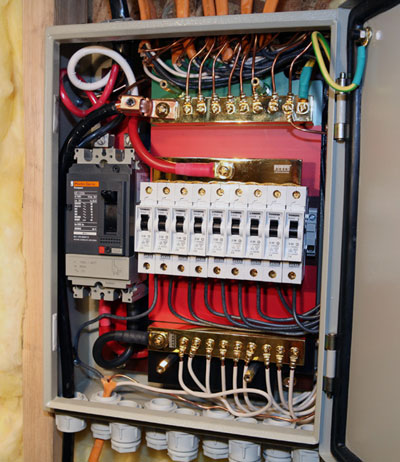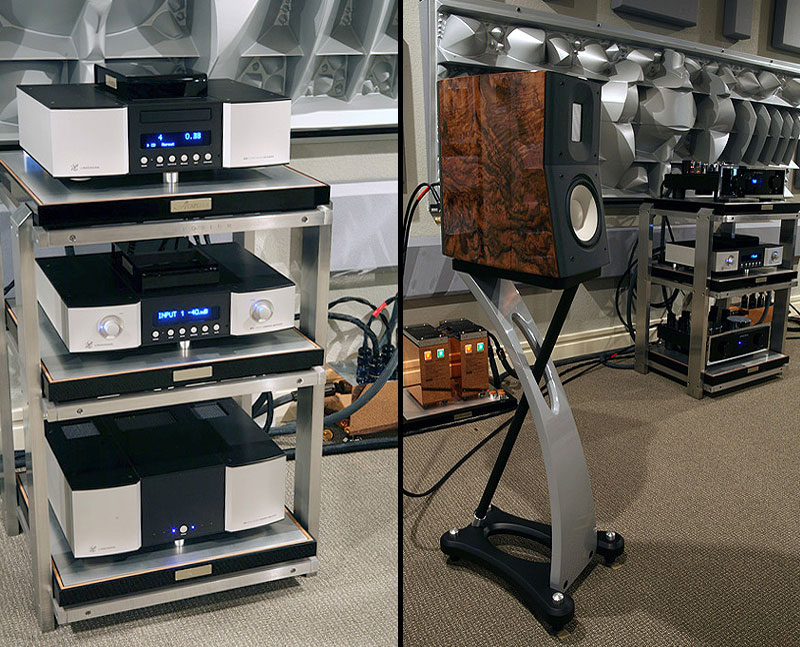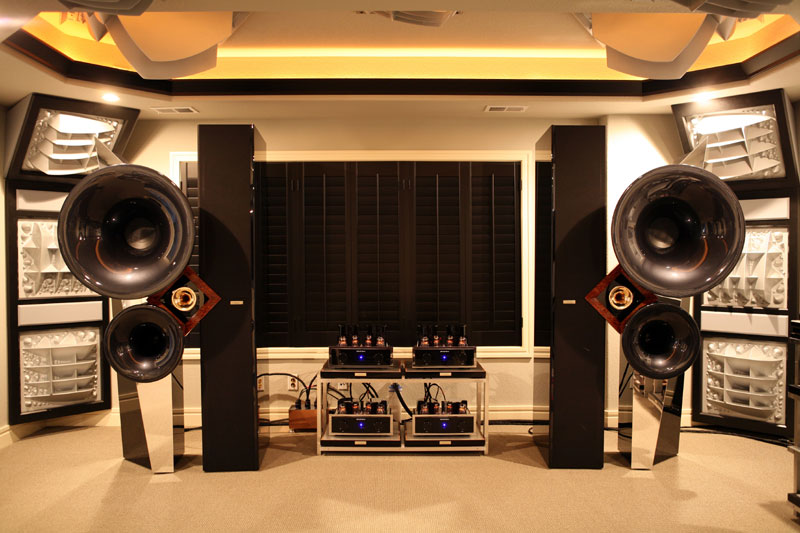 November 2008
Rocky Mountain High End
 Parker, Colorado, is about 35 minutes from downtown
Denver, making it a distant suburb of the Mile High City. After years in Southern
California, Brian Ackerman moved his company, Aaudio Imports, here and set up shop in a
large custom-built house. It is from Colorado that he distributes some well-known European
and Asian brands, including Acapella, Einstein, Lindemann, Raidho, Millennium Audiotrade,
Isoclean, and Stage III Concepts. I was here to see and hear "the system," a
collection of the very best audio components that Brian represents, and one of the most
costly audio systems I've ever heard. But there was much more to discover -- two other
complete audio systems, and a power-delivery system that is truly second to none. Parker, Colorado, is about 35 minutes from downtown
Denver, making it a distant suburb of the Mile High City. After years in Southern
California, Brian Ackerman moved his company, Aaudio Imports, here and set up shop in a
large custom-built house. It is from Colorado that he distributes some well-known European
and Asian brands, including Acapella, Einstein, Lindemann, Raidho, Millennium Audiotrade,
Isoclean, and Stage III Concepts. I was here to see and hear "the system," a
collection of the very best audio components that Brian represents, and one of the most
costly audio systems I've ever heard. But there was much more to discover -- two other
complete audio systems, and a power-delivery system that is truly second to none.
The lower level of Brian's house -- multiple
demonstration rooms and an office -- is devoted to audio and home theater. Brian is
pathologically neat; there's a place for everything, and everything is always in
its place. As he showed me around his office, his repair area, and his shipping area, I
realized that while I'm orderly, he is the Michelangelo of organization.
It was when we entered the main demo room that
thoughts of what I was seeing turned to what I'd be hearing. This isn't a huge room, 24
1/2"L x 19 1/2"W with a ceiling starts at 8' high and reaches 9', but it has
been treated to a fare-thee-well with Golden Acoustics products, which look like armor
you'd see bolted to Mad Max's car. There were $40,000 worth of treatments here, each put
in place strategically. Indeed, this seemed to be a neutral room -- neither lively nor
damped -- a good thing, given that it housed audio systems at each end.
We proceeded to another demo room that's at the
back of the main room. Here also is the entrance to the bowels of Brian's house, where
many of the mechanicals are housed along with the breaker box. When you have as much audio
equipment on display as Brian does, you need to have a serious power-delivery system. As
with everything else, Brian has gone the extra mile, using a gleaming Isoclean Zero Ohm
breaker panel ($4995) that's heavy with copper and gold plating. This works in conjunction
with an ATI Tectoniks Ionic Earthing Array grounding system ($4500 including installation)
that is like nothing I've seen. It essentially integrates the ground rod -- a three
segment copper pipe -- with the soil around it through the release of free ions, making
the soil more conductive. The only outward sign of this system is a small-diameter
plastic-capped well on the side of Brian's house and near the foundation. Brian credits
both the breaker panel and grounding system with dramatically lowering the noise floor of
any equipment he uses. Both are dedicated only to his use; the rest of the house has its
own circuits.
The pile of demo CD-Rs I had carried with me was
making my hand sweat, so, after the protracted show and tell, it was finally time to do
some listening. I started in the back room, where NAD Masters Series M3 integrated amp ($2800) and M5 CD/SACD player ($1800) fronted a pair of Raidho X-Baby
Mk 2 minimonitors ($6600 per pair), which sat on Sound Anchor speaker stands ($745 per
pair). Acapella High LaMusika interconnects ($3300 per meter pair) and speaker cables
($6800 per two-meter pair) connected everything, and Isoclean power products were in
liberal use. The smallish room, 12'L x 10 1/2"W x 8'H, was also treated with Golden
Acoustics products, though only $3500 worth of them.
I've heard the Raidho speakers, which use the
company's own ribbon tweeters, at shows, where they generally tend to spotlight the
treble, bordering on brightness if not actually reaching that dubious plateau. Here, in
this well-treated room that was roughly the size of a second bedroom, the speakers sounded
highly articulate and pure without turning nasty. I had the distinct sense that the room
was leaving the sound of the speakers and electronics intact, not influencing it to any
degree. I listened to a few Gillian Welch cuts -- I find her wistful voice to be a good
test of midrange transparency -- and realized that I could have listened here all night,
such was the unadulterated resolution of this system and room.

Next up was another system fronted
by Raidho minimonitors, the one opposite the reference system in Brian's main listening
room. This time, the speakers were from the Ayra series, the C1.0s ($13,200 per pair),
which rested on some of the most ingenious and sculptural speaker stands I've ever seen.
These, called the C1.0 speaker stands ($2900 per pair), are also made by Raidho, and they
completely decouple the speakers from the floor while giving them a solid foundation on
which to rest. A stack of Lindemann electronics -- 820S CD/SACD player ($21,700), 830
preamp ($13,900) and 855 power amp ($19,000) -- was tethered with Stage III Concepts
Gryphon interconnects ($5800 per meter pair), and Acapella High LaMusika speaker cables
($9900 per three-meter pair) connected the speakers. Various Isoclean power products,
along with a Symposium rack frame and Acapella equipment platforms, completed this system.
Here, the speakers were much farther apart than
the smaller X-Baby Mk 2s were in the other room, and they filled in nicely, conjuring an
immense soundstage with no holes laterally. Interestingly, the Raidho Ayra C1.0 speakers
sounded a bit polite here, displaying some reticence in the lower treble -- that is until
Brian swapped in some Stage III Concepts Mantikor speaker cables ($13,200 per two-meter
pair), which increased the midrange and treble energy, ameliorating the reticence and
bringing this entire system to life. The difference was like night and day, my
Gillian Welch cuts sounding bigger and more detailed than they had on the system in the
back room. I was so impressed with the Ayra C1.0 speakers that I immediately discussed a
review of the larger floorstanding Ayra C3.0s, a pair of which is sitting in my listening
room right now.
It was time to turn attention to the other end of
the room, where the immense Acapella Triolon Excalibur speakers resided. These cost
$192,000 per pair and resemble geometric sculptures, due to their multi-piece
configuration. A massive woofer column mates with midrange horns and a single ion tweeter,
which might be the most refined-sounding high-frequency transducer extant. Driving the
speakers were two pairs of Einstein Final Cut Mk 60 mono amps ($32,700 per pair), an
output transformerless design that delivers 60 watts. The Acapella speakers are said to be
94dB sensitive and therefore will play to loud levels with as few as 15 watts. They can
also be triamped, which Brian has considered, noting only the extra room needed for the
amps and the extra heat they'd put out as deterrents. Never mind the nearly $33,000
additional cost!
The preamp for such a speaker system is an
important choice. It must be low in noise, or the speakers and amplifiers will make the
noise's presence known. Luckily, Brian sells the perfect preamp, Einstein's The Tube Mk 2
($17,400), the initial version of which I reviewed, noting its utter lack of background
noise, a trait that Brian's power-delivery system only maximizes. There were analog -- an
Oracle Delphi Mk V turntable with SME V tonearm and Einstein TU-3 cartridge ($4700) along
with an Einstein The Turntable's Choice balanced phono stage ($9100) -- and digital --
Einstein's The Source CD player ($16,900) -- with Acapella High LaMusika balanced
interconnects ($3300 per meter pair) and High LaMusika speaker cables ($9900 per
three-meter pair) connecting everything. Power cords were also Acapella High LaMusika
($5500 each), with various Isoclean power-conditioning products and power cords in use,
along with Acapella isolation bases and couplers.

If you're trying to do the math, I'll save you
the effort. All told, this system, including the room treatments and power system, cost
over a half-million dollars to assemble. The speakers are big, there is plenty of power on
tap, and the room is acutely treated, all of which might lead you to believe in the
system's ability to overwhelm, leaving you to utter phrases like "flabbergasted"
and "blown away" in the process. Instead, this system sneaks up on you, which is
not a euphemism for "it sounds OK" but rather an expression of the unassuming
splendor of this combination of speakers, electronics and wires. With female vocal --
again, Gillian Welch -- the Acapella speakers sounded sweet and airy. With something more
raucous, like Chris Thomas King's "John Law Burned Down the Liquor Store," their
authority kicked in. The bass was well controlled, not overpowering in any way, while the
treble was redolent with mellifluous overtones, a kind of resolution as finely drawn as
silk thread. I came away from hearing this big, impressive-looking system in awe of its
way of conveying emotion. Instead of feeling like the proverbial guy in the Maxell ad
blown back by the sheer power of the sound, which could certainly happen here, I leaned
into the music, drawn in by the holographic imaging and the refinement of that tweeter.
After dutifully playing a number of cuts from my
CD-Rs, Brian decided to play something for me. I immediately wondered what he'd pick -- a
symphonic masterpiece or perhaps a jazz ensemble recorded with purist techniques,
something that would show off his over-the-top system. After of few moments of silence, I
heard a voice I recognized. It was Dean Martin! He was singing "I'll Buy That
Dream," a cut I'd never heard before. The system adapted, sounding more immediate
than it had with my music, conveying a chiseled three-dimensional presence along with the
treble refinement.
This was the last track I'd hear, and one I'll
certainly remember. If you visit Brian to hear "the system," be sure to ask him
to play it. It nicely sums up what you may be feeling.
...Marc Mickelson
marc@soundstage.com
|

